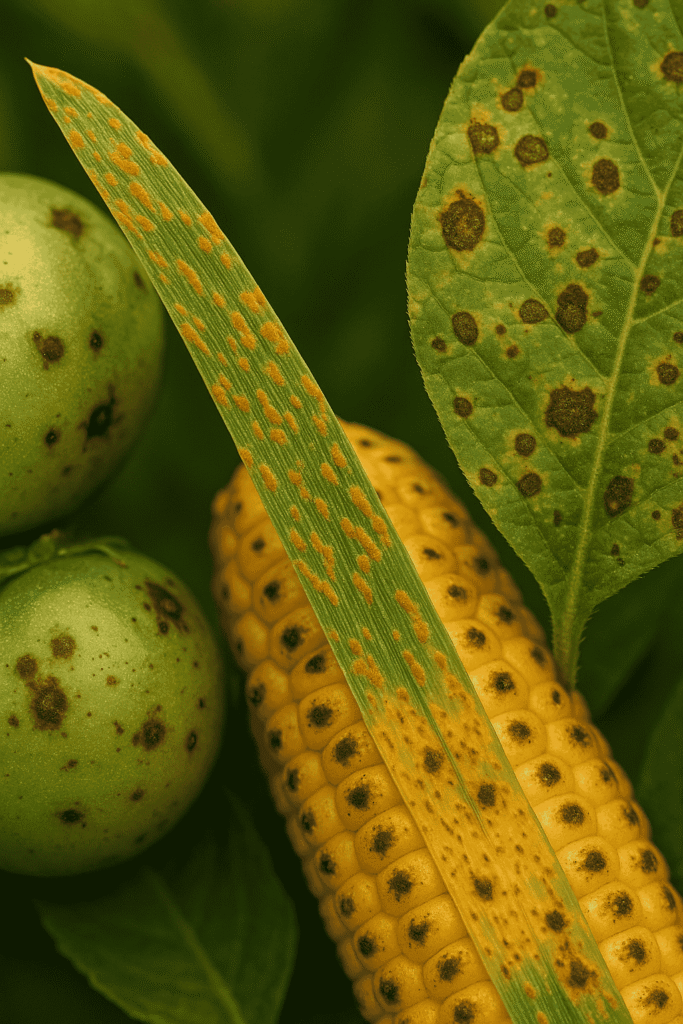Introduction: Why Agriculture Major Diseases Matter
Agriculture major diseases are one of the biggest threats to Pakistan’s food security, economic stability, and rural livelihoods. As agriculture contributes nearly 20% to the national GDP and employs over 38% of the population, any disruption—especially from crop diseases—can ripple across the economy. In 2025, farmers continue to face recurring problems such as fungal infections, bacterial blights, and viral epidemics in key crops like wheat, rice, maize, and cotton.
Without effective disease management, Pakistan loses up to 25% of crop yields annually, according to reports by the Food and Agriculture Organization (FAO). Identifying and controlling these major diseases is now a national priority.
🌾 Wheat Rust: A Fungal Threat to Food Security
Wheat is Pakistan’s most critical staple crop. Among the agriculture major diseases affecting wheat, rusts are the most damaging.
🔬 Cause and Symptoms:
Rust diseases are caused by Puccinia fungi, which appear as yellow-orange or brown powdery spots on leaves and stems. These infections reduce photosynthesis and weaken plant structure.
🛡️ Control Measures:
- Use rust-resistant varieties like Punjab-2011 and Galaxy-2013
- Apply preventive fungicides during tillering and booting stages
- Practice crop rotation with non-cereal crops
🌾 Rice Bacterial Leaf Blight (BLB): A Waterborne Menace
BLB is among the most common agriculture major diseases in Pakistan’s rice-growing regions, especially in Punjab and Sindh.
🔬 Cause and Symptoms:
Caused by Xanthomonas oryzae, BLB starts with water-soaked lesions that turn yellow and spread across the leaves, eventually leading to wilting and drying.
🛡️ Control Measures:
- Use certified, BLB-resistant seeds (KSK-133, IR-6)
- Avoid over-irrigation and standing water
- Apply copper-based bactericides and manage nitrogen levels
🌽 Maize Turcicum Leaf Blight: A Hidden Yield Killer
Maize is increasingly important for both food and livestock feed. Turcicum Leaf Blight is a widespread fungal disease seen mostly during humid conditions.
🔬 Cause and Symptoms:
Caused by Exserohilum turcicum, it presents as long, elliptical grey lesions on leaves, reducing photosynthesis and stunting growth.
🛡️ Control Measures:
- Use resistant hybrids like Pioneer-Shahkar, DEKALB 6321, Sohni Dharti SD 3555
- Avoid planting maize in the same field every season
- Apply protective fungicides before disease peaks
🏵️ Cotton Leaf Curl Virus (CLCV): A Cash Crop Crisis
Cotton, once a leading export earner for Pakistan, has been severely affected by CLCV, one of the most devastating viral diseases.
🔬 Cause and Symptoms:
Transmitted by whiteflies, CLCV causes leaves to curl, thicken, and develop dark green veins. It leads to reduced boll formation and poor fiber quality.
🛡️ Control Measures:
- Grow CLCV-tolerant Bt cotton varieties
- Control whitefly population with integrated pest management (IPM)
- Remove nearby host plants and weeds
🔗 External Link: CABI – Cotton Leaf Curl Disease Factsheet
🥔 Late Blight in Potatoes: The Winter Destroyer
Among vegetables, Late Blight is one of the top agriculture major diseases, particularly during cool, moist winters in Pakistan.
🔬 Cause and Symptoms:
Caused by Phytophthora infestans, it causes dark, water-soaked spots on leaves and blackened, rotting tubers.
🛡️ Control Measures:
- Use disease-free seed tubers
- Ensure proper drainage and airflow in fields
- Apply systemic fungicides like metalaxyl at early signs
📌 Internal Link: Potato in Pakistan: Full Production & Disease Guide
🌿 Integrated Disease Management (IDM): Smarter Farming for a Healthier Future
Controlling agriculture major diseases sustainably means reducing dependence on chemical sprays and adopting Integrated Disease Management (IDM):
- Use certified and disease-resistant seeds
- Follow timely crop rotation
- Ensure proper plant spacing and sanitation
- Monitor climate and apply targeted treatments
- Introduce biological agents like Trichoderma
🔗 External Link: ICARDA – Integrated Pest and Disease Management
⚠️ Root Causes of Widespread Disease
- Climate variability (humidity and rising temperatures)
- Excessive use of nitrogen fertilizers
- Monoculture cropping and poor field hygiene
- Weak extension services and lack of farmer awareness
- Unregulated seed markets
🏛️ Government & Institutional Response
While the Ministry of National Food Security & Research (MNFSR) and provincial agriculture departments have launched disease monitoring programs, outreach remains low in rural areas.
To address this, there is an urgent need for:
- Mobile-based disease alert systems
- Farmer field schools
- Subsidized diagnostic labs and bio-pesticides
- Agri-clinics at village level
🔗 External Link: MNFSR Official Website
🔚 Conclusion: Healthy Crops, Strong Pakistan
Conclusion: Healthy Crops, Strong Pakistan
In a country where agriculture fuels the economy and feeds millions, the health of crops directly impacts national strength. Combating major diseases in agriculture is no longer an option — it is a necessity. When crops suffer from blights, rusts, or viral infections, the entire agricultural value chain is disrupted, from farmer incomes to national food security. By investing in disease-resistant seed varieties, improving early detection systems, and training farmers on integrated pest and disease management, Pakistan can drastically reduce the losses caused by major diseases. Government initiatives, research institutions, and agri-tech startups must collaborate to promote sustainable farming practices that ensure long-term crop health.
Healthy crops mean higher yields, stable rural incomes, and lower food inflation — all key to economic resilience. Moreover, healthier agriculture contributes to better environmental outcomes through reduced chemical inputs and improved soil management. To build a future-proof agricultural system, we must treat plant health with the same urgency as human health. After all, a nation with healthy crops is a nation with strong roots. Let’s protect our fields, empower our farmers, and secure Pakistan’s agricultural future — because Healthy Crops mean a Strong Pakistan.
